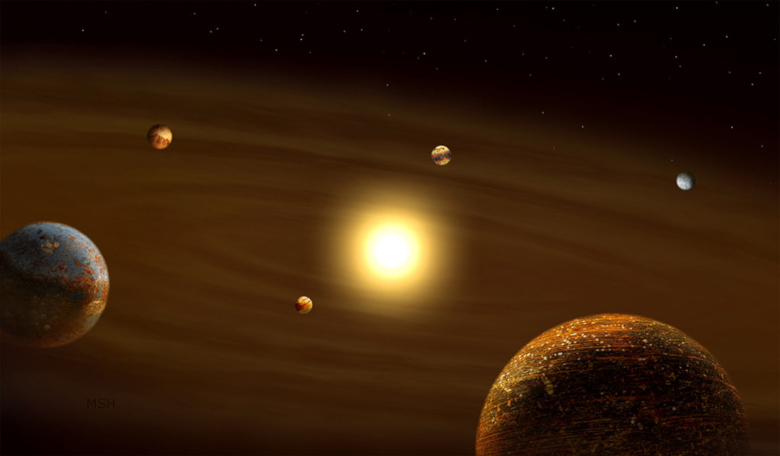After a year in space scanning the skies in the Southern Hemisphere, NASA’s latest planet hunting telescope TESS (Transiting Exoplanet Survey Satellite) has helped astronomers discover a bumper haul of 21 planets outside our solar system and it is hoped that even more exoworlds will be found as TESS now turns its attention to the Northern Hemisphere to complete the most comprehensive planet-hunting expedition ever undertaken.
As wonderful as this news is, TESS is not the only one making substantial discoveries. Although now officially retired, NASA’s first formidable exoplanet telescope – Kepler – has gone one better. Make that a few hundred better.
By scanning through eight datasets collected by Kepler’s K2 campaigns between 2014 - 2016, researchers have identified a whopping 374 previously undiscovered planets; 25 of them whizz round their host star in less than a day, one is potentially rocky and in the habitable zone and 87 are in multi-planet systems – one of which is a six-planet system where all the worlds are close in to the host star and the largest is only three times the size of Earth.
During nearly a decade of service, Kepler observed a staggering 530,506 stars and detected over 2,600 planets; a remarkable feat given that four years after its launch, the telescope succumbed to technical failures which meant that it’s current mission objectives could not be met.
Not wanting to give up on this hugely successful planet hunter, instead of being able to monitor Earth-like planets around main sequence stars like our sun as it was designed to, it was proposed that Kepler search for habitable worlds around smaller, dimmer red dwarfs in a different direction to which it had been looking – a workaround to overcame its new limitations. Its second shot at planet-hunting came with a new mission title – K2 – and 15 months after being reassigned to its new stellar target, Kepler had racked up its 1,000th confirmed exoplanet discovery.
Kepler’s K2 mission comprised of 19 ‘campaigns,’ lasting around 80 days each. These new discoveries were all extracted from data collected on 152,865 stars during its first eight campaigns.
A total of 818 transiting planet candidates were found by the team, whose lead author is Ethane Kruse at NASA Goddard Space Flight Centre, after they used a certain type of algorithm (called a detrending algorithm) to wade through the vast reams of information and locate would-be exoplanets.
Of these 374 were detections that had not been discovered by prior searches. As these are planet candidates they have yet to be confirmed as real, but the authors are confident that based on data from the multi-planet systems, most if not all of the candidates will be actual exoplanets once follow up investigations are complete.
One of the interesting aspects of Kruse and colleagues work is that it draws parallels with a previous study in 2017 that identified something called the Radius Gap. The Radius Gap describes what seems to be an apparent lack of planets with sizes between 1.5 to 3.8 Earth radii – the super-Earth to mini-Neptune class of exoplanet.
Why would planets of this size appear to be rare? One explanation to account for the anomaly, is that the planet’s atmosphere has been evaporated away after being bombarded by high energy radiation from its host star; a process that ultimately leads to the planet losing mass. Conversely, any planets that have managed to hold onto their gaseous skies seem inflated compared with their stripped down cousins.
This recent study also shows a similar trend - a gap in the number of planets whose radius is twice that of Earth’s (I.e 2 Earth radii). While the jury is still out on what might be causing this dearth in planets of this size, studies of this type could help determine the origin of the problem, if there indeed is one.
This sizeable investigation into exoplanet numbers has also highlighted a wealth of other compelling properties. Along with the already alluded to six planet system (called EPIC 210965800), with worlds that range from 1.5 – 3.8 Earth radii all orbiting a sub-solar star, 2 five planet systems known as EPIC 211413752 and EPIC 211428897 and 5 four planet systems have also been identified. In total, 93 of the 374 newly spotted planet candidates were found in multi-planet systems.
And last, though very much not least, Kruse and colleagues have found 73 newly identified reciprocally transiting planet candidates. Reciprocally transiting planets are as the name suggests, a mutual situation whereby the planet in question would be able to see, from its point of view, at least one planetary transit from worlds within our Solar System.
Could an advanced species on one of these planets be waving back at us? Possibly, as 12 of the multi-planet systems found by Kruse and colleagues, including a four-planet system would be able to see transits of the Earth as it passed in front of the Sun.
More details on this research can be found here.











